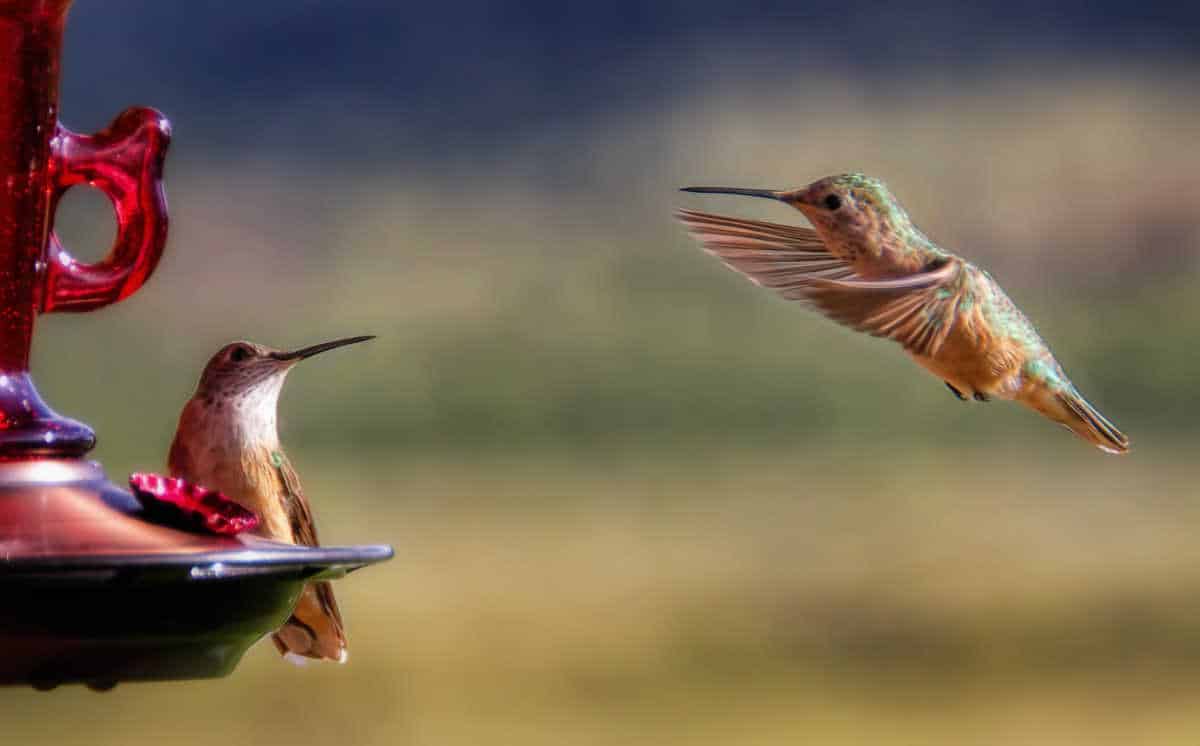This hummingbird nectar recipe uses simple ingredients you probably have on hand. It’s easy to make and you can keep a supply in the refrigerator to refill your hummingbird feeders all week long.
The first time I saw a hummingbird was during dinnertime. I was around 10 years old. We lived in a small suburban house right on the edge of Queens, New York, where the houses were so close together you could sit in your dining room and look right into the living room of the house next door.
My dad had hung window boxes on the dining room windows and planted them with geraniums. And there, glinting in the warm glow of the setting sun, was a jewel-bright hummingbird. I watched in delight from my seat at the dining room table as he sipped nectar from the florets of the red geraniums
Why Should You Feed Hummingbirds?
Hummingbirds consume and utilize an incredible amount of energy. Their tiny hearts beat 1,200 times per minute and they can beat their wings at an astonishing rate of 200 times per second.
Hummingbirds migrate incredible distances, too. Here in North America, hummingbirds migrate from northern climates to the Gulf of Mexico, spending their winters in the warmth of the Florida sunshine (lucky birds) or along the Gulf Coast states. In the spring, they begin their migration, often traveling hundreds of miles. Unlike other bird species, they tend to migrate alone rather than in large groups.
Males typically arrive first, perhaps to scout out nesting areas. Most migrating hummingbirds finish their journey in only a few days, traveling up to 25 to 30 miles a day.
Now you know why you should feed hummingbirds! The amount of energy needed for these tiny miracles to travel far and fast means they burn a tremendous number of calories per day. Hanging up your hummingbird feeder, filling it with homemade hummingbird food, and cleaning it weekly during migration season in the spring and fall could mean life or death for these beautiful creatures.

What Do Hummingbirds Eat?
Hummingbirds eat insects as well as sip nectar. They eat spiders, small insects, and even tree sap as well as small fruits. Approximately 90% of their diet is nectar, either from flowers or feeders, and the remaining 10% consists of insects.
Hummingbirds Love Red Flowers
It’s no coincidence that my first glimpse of a hummingbird was on a red flower. Hummingbirds are attracted to the color red. Nature provides the highest-quality nectar in red flowers for hummingbirds and they are naturally attracted to it.
Do I Need to Add Red Food Coloring to My Homemade Hummingbird Nectar?
No – not at all. Although in the past many recipes for hummingbird nectar included red food color in the list of ingredients, ornithologists (scientists who study birds) agree it isn’t necessary.
Many commercial hummingbird feeders are red or have bright red decorations on them. This alone will attract hummingbirds to your feeder.
Hummingbird Nectar Recipe
To make your own hummingbird nectar, you’ll need sugar and water – that’s it!
Do not use any sweetener other than refined white table sugar to make hummingbird nectar. Using honey or molasses in a nectar recipe can KILL hummingbirds. Do not use it. Even a little is too much.
Artificial sweeteners are also poisonous to hummingbirds. Use only refined white sugar to make a hummingbird nectar recipe.
To make hummingbird food, mix water and sugar at a 1:4 ratio. This means adding 1 cup of sugar to 4 cups of water. Pour the water and sugar into a sauce pan and heat to boiling, stirring frequently. Boil until the sugar is dissolved, then turn off the heat and let the mixture cool.
When the mixture is cool, you can fill your hummingbird feeders. Pour the rest into a glass container, cover it, and store it in the refrigerator for up to one week. Refill feeders are necessary.
How to Clean Hummingbird Feeders
It’s important to clean hummingbird feeders weekly to avoid mold from building up. Mold, yeast, and fungus love sugar, and they will grow inside the hummingbird feeder as well as on the little nectar ports where the birds drink.
To clean a hummingbird feeder, empty any remaining hummingbird nectar. Disassemble the feeder. Rinse it in hot water. I use a mild soap and a toothbrush I keep just for cleaning purposes to scrub out the inside of the feeder and the ports.
If you see black mold or smell a fruit smell, this means there may be mold or fungus in the feeder. Soak the feeder and all its parts in a solution of 2 parts water to 1 part white vinegar. (2 cups of water and 1 cup of vinegar). Soak for an hour, then remove the feeder and parts from the solution, and rinse them thoroughly under warm running water. Dry and refill the feeder, then hang it back where it was before.
Hummingbirds love consistency and will note where good food sources are in the course of their migration and daily activities. If you plan to feed hummingbirds, select a good location for your feeder, one that’s near enough the house so you can’t miss their antics.
You can’t make hummingbirds ‘dependent’ on feeding them, and it does them only good to provide them with simple homemade hummingbird nectar. Brew up a batch tonight so you can refill (after cleaning, of course!) your feeders tomorrow.




